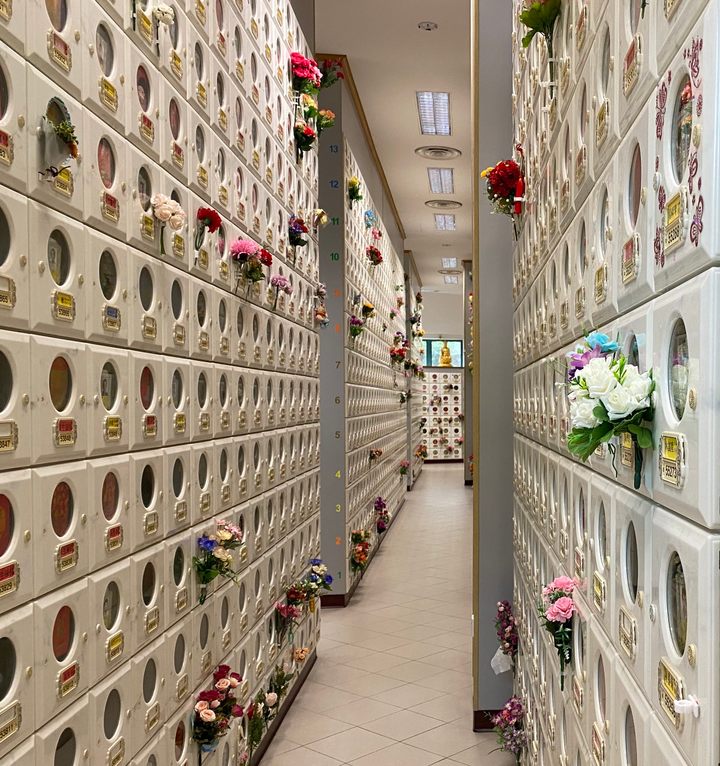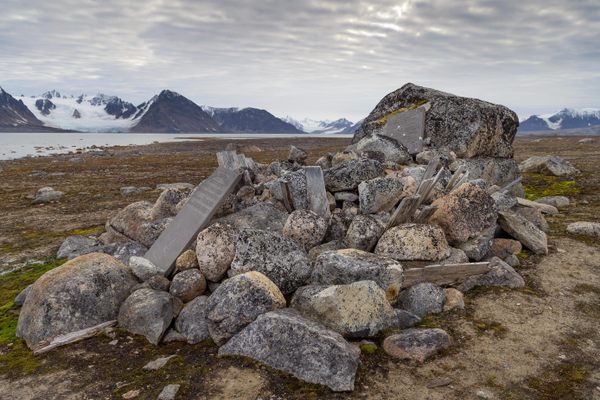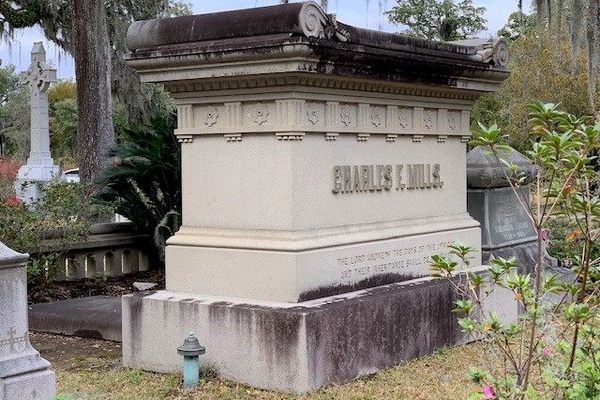
Why Singapore Is Digging Up Its Few Remaining Cemeteries
With land in short supply, families are forming new traditions.
On a warm December day in one of the last cemeteries in Singapore, Man Zu begins to chant. His orange Taoist robes stand out amidst the thousands of gray gravestones; his round face is tan and leathered from years of working in the sun. He is here today to help a group of siblings exhume and relocate the remains of their father, mother, and uncle.
Choa Chu Kang Cemetery does not look like the busy metropolis that is Singapore. There is barely a building in sight; the tallest structure stands about 1,000 feet away, a single-story building equipped with a food stall. In the vicinity, there is a branch of the National Environment Agency, situated near the cemetery to help families exhume their ancestral graves.
Much of the cemetery looks dilapidated, dotted with heaps of rubble and clumps of weeds. The air smells of mud, sand, and grass. Destroyed tombstones stand next to others that are still intact, scattered with miscellaneous debris: incense holders, empty Oreo packets, broken vase fragments. Stray dogs, a rare sight in urban Singapore, patrol the area.
The mass obliteration of graves—or, as it is more commonly known, exhumation—is a result of the government’s redevelopment plans. The Choa Chu Kang Cemetery Exhumation Programme was announced in 2017 to make space for the expansion of an airbase, which necessitates the relocation of more than 80,000 graves. The Cemetery is home to Chinese, Muslim, and Hindu graves. In the current phase, more than 45,500 Chinese graves will be exhumed.

Choa Chu Kang Cemetery’s fate is a mirror of what happened to Bukit Brown Cemetery in 2013. At the time, Singaporeans protested its destruction. Bukit Brown was the resting place of key historical figures and home to a quarter of the bird species in Singapore, but it was was partially* demolished to make space for a new highway.
As recently as 1978, there were 213 cemeteries in Singapore, with burial grounds both large and small scattered across the island. (At approximately 278 square miles, the entire country is smaller than New York City.) By 2011, there were only 60 cemeteries. Many estates and malls stand on former cemeteries, from Singapore’s most popular shopping district, Orchard Road, to residential neighborhoods in the heart of the city-state.
Though most cemeteries have been demolished, the few that remain serve as reminders of the many communities that have called Singapore home. The Japanese Cemetery Park, established in 1891, offers a glimpse into the world of early Japanese settlers: soldiers, merchants, young women brought to Singapore as sex workers. Cemeteries also showcase Singapore’s religious and cultural diversity, with designated sites for Christians, Hindus, Muslims, Jews, and the different Chinese clans.
Today, only one—Choa Chu Kang Cemetery—is active. Even then, the government imposes a burial period of 15 years, after which families must relocate the remains.
Jo’s father, mother, and uncle have resided here since the 1980s. She is here today with the rest of her family to exhume all three graves. Since each exhumation takes about an hour, they have decided to divide and conquer: Jo oversees the exhumation of her mother’s grave with her children, and her brothers have split up to attend to the other two graves.

Two workers from the National Environment Agency stand by to help collect the remains, which will be cremated and stored at the government-owned Mandai Crematorium and Columbarium.
After the Taoist rites are complete, gravediggers clear away the soil, revealing the surface of a wooden coffin. A tarp, propped up by poles, covers the grave, preventing the dead from being exposed to sunlight. “Ma!” Jo exclaims, when they approach the grave. She starts singing a classic Chinese children’s song: “Only mother is good in this world.”
The worker breaks open the coffin. The lid is still intact, though visibly worn down. They had used good quality wood, Jo points out. The worker descends into the grave, muddy water coming up to his knees.
Calmly and deliberately, the gravedigger moves remains from the coffin into a white bucket. He also recovers pieces of clothing and a rectangular black block: joss paper, or paper money that was buried with the dead. Some of the bones are blackened from their years underground; some are large and long, while others are small and brittle. The last to come out is the skull. Jo calls out in the Chinese dialect of Hokkien: “Mama, we’re moving house.”
In 2019, a man named Tan helped his family move his grandmother’s remains from Choa Chu Kang Cemetery to a repository for ashes of the deceased, Kong Meng San Phor Kark See Columbarium. The family has yet to celebrate the annual Qing Ming, or Tomb-Sweeping Day, at his grandmother’s new home. He fears that few people will show up. “There’s no space here,” he explains, gesturing down a narrow aisle.
Kong Meng San Phor Kark See Monastery is the largest monastery in Singapore, with two dedicated columbaria within the compound. Tan’s grandmother is located at the newer, more modern one, next to thousands of cremated neighbors. (Due to COVID-19, visits are currently by appointment only, masks are required, and groups are restricted to five members of the same household.)
The niches for each set of ashes are organized into blocks and lined up in rows inside the air-conditioned room. Some are so high that they can’t even be seen, and nearly touch the ceiling.

Death is expensive in Singapore, given the scarcity of land here: Prices run up to $7,000 for a single niche (less-visible units are cheaper). A few niches have been purchased but are not yet occupied, and some are marked with a hongbao, the red envelope usually stuffed with money for Chinese New Year. Others show signs of recent visits, such as flowers, keychains, and even small food magnets.
Tan says that his grandmother’s new home has changed the family’s traditions. “We would gather at seven in the morning at my father’s place, and then drive to the cemetery,” Tan explains. “Then we would sweep the tomb and the whole family would picnic together. How can you do that here?”
In the columbarium, there’s not enough space for the usual offerings of rice, roast pork, and other dishes to be placed near the ashes. Instead, the monastery has an allocated outdoor space where families can lay out feasts for the dead.
The practice of burning joss paper, too, has been streamlined for efficiency. An Eco-Burner has been installed in a parking structure nearby, where joss paper is collected from families and burnt in bulk by staff members.
By 1985, Singapore had already exhumed 21 cemeteries. According to the government, cemeteries take up too much space, and Singapore needs to grow if it is to accommodate its nearly six million residents. Some families scatter their ancestors’ ashes at sea; columbaria are a more permanent alternative.
Tightly pressed together, the rows of niches in columbaria look almost like Singapore’s ubiquitous public housing blocks, each one almost indiscernible from the next. It’s even possible that apartments will eventually replace columbaria, says Bernard Chen, who studied history at Oxford University and has experience in the funeral services industry.

Under British colonial rule, Chen explains, burial grounds were located on the outskirts of the downtown area. But as the city of Singapore grew and more space was needed, cemeteries were seen as “space wasters.” As early as 1952, a Burials Committee had already been set up to encourage cremation instead of burials.
“Whenever the state appropriates land for the dead as land for the living, it always uses the same narrative, which is that the land is for national development.” Chen says. “If you bring this to its logical conclusion, in time to come, there will be zero land for the dead.”
“When we are left without cemeteries, what is the next collective community to be sacrificed on the altar of national development? Columbariums.”
For the sake of national development, the dead are constantly moving house: from cemeteries to columbaria and perhaps even into homes. “Because the state squeezes the land out for the living, it’s either you dump the ashes out to sea, or you bring the ashes home,” Chen says. “Every single unit [becomes] an urn space.”

In land-scarce Singapore, where a luxury apartment can cost thousands of dollars per square foot, urban redevelopment demands that the dead make way for the living. With that, rituals of death like Taoist rites and ancestral worship are uprooted along with places of death.
The destruction of Singapore’s cemeteries is striking, but it is not sudden or surprising. It is an ongoing project that started before the nation’s independence, and Singaporeans have accepted and adapted to it, with some reluctance. Still, Tan worries about what will be lost in a country without cemeteries as places to gather and remember the dead. “At Qing Ming, we would have 40, 50 people, three generations all attending,” he recalls. “It was the only time they would come together.” He looks at the columbarium, holds out a photo of his family at the cemetery, and shrugs. “It’s different, right?”
Correction: A previous version of this story stated that Bukit Brown Cemetery was demolished to make space for a new highway. It was partially demolished.

















Follow us on Twitter to get the latest on the world's hidden wonders.
Like us on Facebook to get the latest on the world's hidden wonders.
Follow us on Twitter Like us on Facebook